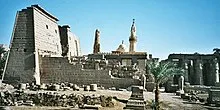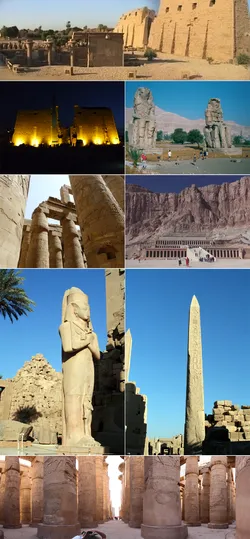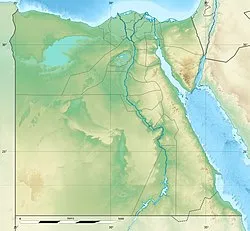 The name Luxor comes from the Arabic al-ʾuqṣur (الأقصر), lit. "the palaces," from the collective pl. of qaṣr (قصر),[5] which may be a loanword from the Latin castrum "fortified camp".[6] (Compare Alcázar of Seville)
The name Luxor comes from the Arabic al-ʾuqṣur (الأقصر), lit. "the palaces," from the collective pl. of qaṣr (قصر),[5] which may be a loanword from the Latin castrum "fortified camp".[6] (Compare Alcázar of Seville)
History[edit]

Luxor Temple
Luxor was the ancient city of Thebes, the great capital of (Upper) Egypt during the New Kingdom, and the glorious city of Amun, later to become the god Amun-Ra. The city was regarded in the Ancient Egyptian texts as w3s.t (approximate pronunciation: "Waset"), which meant "city of the sceptre" and also as t3 ip3t (conventionally pronounced as "ta ipet" and meaning "the shrine") and then, in a later period, the Greeks called it Thebai and the Romans after them Thebae. Thebes was also known as "the city of the 100 gates", sometimes being called "southern Heliopolis" ('Iunu-shemaa' in Ancient Egyptian), to distinguish it from the city of Iunu or Heliopolis, the main place of worship for the god Re in the north. It was also often referred to as niw.t, which simply means "city", and was one of only three cities in Egypt for which this noun was used (the other two were Memphis and Heliopolis); it was also called niw.t rst, "southern city", as the southernmost of them.
The importance of the city started as early as the 11th Dynasty, when the town grew into a thriving city, by native nubi Egyptian, it was renowned for its high social status and luxury, but also as a center for wisdom, art, religious and political supremacy.[7] Montuhotep II who united Egypt after the troubles of the first intermediate period brought stability to the lands as the city grew in stature. The Pharaohs of the New Kingdom in their expeditions to Kush, in today's northern Sudan, and to the lands of Canaan, Phoenicia and Syria saw the city accumulate great wealth and rose to prominence, even on a world scale.[7] Thebes played a major role in expelling the invading forces of the Hyksos from Upper Egypt, and from the time of the 18th Dynasty to the 20th Dynasty, the city had risen as the political, religious and military capital of Ancient Egypt.
The city attracted peoples such as the Babylonians, the Mitanni, the Hittites of Anatolia (modern-day Turkey), the Canaanites of Ugarit, the Phoenicians of Byblos and Tyre, the Minoans from the island of Crete.[7] A Hittite prince from Anatolia even came to marry with the widow of Tutankhamun, Ankhesenamun.[7] The political and military importance of the city, however, faded during the Late Period, with Thebes being replaced as political capital by several cities in Northern Egypt, such as Bubastis, Sais and finally Alexandria.
However, as the city of the god Amun-Ra, Thebes remained the religious capital of Egypt until the Greek period.[7] The main god of the city was Amun, who was worshipped together with his wife, the Goddess Mut, and their son Khonsu, the God of the moon. With the rise of Thebes as the foremost city of Egypt, the local god Amon rose in importance as well and became linked to the sun god Ra, thus creating the new 'king of gods' Amon-Ra. His great temple, at Karnak just north of Thebes, was the most important temple of Egypt right until the end of antiquity.
Later, the city was attacked by Assyrian emperor Assurbanipal who installed the Libyan prince on the throne, Psamtik I.[7] The city of Thebes was in ruins and fell in significance. However, Alexander the Great did arrive at the temple of Amun, where the statue of the god was transferred from Karnak during the Opet Festival, the great religious feast.[7] Thebes remained a site of spirituality up to the Christian era, and attracted numerous Christian monks in the Roman Empire who established monasteries amidst several ancient monuments including the temple of Hatshepsut, now called Deir el-Bahri ("the northern monastery").[7]
Sights of modern-day Luxor[edit]
East bank
Luxor Temple
Luxor International Airport
Karnak Temple
Luxor Museum
Mummification Museum
Winter Palace Hotel
A panoramic view of the great hypostyle hall in the Precinct of Amun Re
West bank
Valley of the Kings
Valley of the Queens
Medinet Habu (memorial temple of Ramesses III)
The Ramesseum (memorial temple of Ramesses II)
Deir el-Medina (workers' village)
Tombs of the Nobles
Deir el-Bahri (Mortuary Temple of Hatshepsut, etc.)
Malkata (palace of Amenophis III)
Colossi of Memnon (memorial temple of Amenophis III)
Climate[edit]
Luxor has a hot desert climate (Köppen climate classification BWh) like the rest of Egypt. Aswan and Luxor have the hottest summer days of any other city in Egypt. Aswan and Luxor have nearly the same climate. Luxor is one of the hottest, sunniest and driest cities in the world. Average high temperatures are above 40 °C (104 °F) during summer (June, July, August) while average low temperatures remain above 22 °C (72 °F). During the coldest month of the year, average high temperatures remain above 22.0 °C (71.6 °F) while average low temperatures remain above 5 °C (41 °F).
The climate of Luxor has precipitation levels lower than even most other places in the Sahara, with less than 1 mm (0.04 in) of average annual precipitation. The desert city is one of the driest ones in the world, and rainfall does not occur every year. The air is mainly dry in Luxor but much more humid than in Aswan. There is an average relative humidity of 39.9%, with a maximum mean of 57% during winter and a minimum mean of 27% during summer.
The climate of Luxor is extremely clear, bright and sunny year-round, in all seasons, with a low seasonal variation, with about some 4,000 hours of annual sunshine, very close of the maximum theoretical sunshine duration.
In addition, Luxor, Minya, Sohag, Qena and Asyut have the widest difference of temperatures between days and nights of any city in Egypt, with almost 16 °C (29 °F) difference.
The hottest temperature recorded was on May 15, 1991 which was 50 °C (122 °F) and the coldest temperature was on February 6, 1989 which was −1 °C (30 °F).[8]

[hide]Climate data for Luxor
Month Jan Feb Mar Apr May Jun Jul Aug Sep Oct Nov Dec Year
Record high °C (°F) 32.9
(91.2) 38.5
(101.3) 42.2
(108) 46.2
(115.2) 48.3
(118.9) 48.5
(119.3) 47.8
(118) 47.0
(116.6) 46.0
(114.8) 43.0
(109.4) 38.2
(100.8) 34.8
(94.6) 48.5
(119.3)
Average high °C (°F) 23.0
(73.4) 25.4
(77.7) 27.4
(81.3) 35.0
(95) 39.2
(102.6) 41.4
(106.5) 41.1
(106) 40.4
(104.7) 38.8
(101.8) 35.3
(95.5) 28.9
(84) 24.4
(75.9) 33.4
(92.1)
Daily mean °C (°F) 13.8
(56.8) 15.9
(60.6) 20.2
(68.4) 25.6
(78.1) 29.6
(85.3) 32.2
(90) 32.3
(90.1) 31.8
(89.2) 29.7
(85.5) 25.9
(78.6) 20.0
(68) 15.1
(59.2) 24.3
(75.7)
Average low °C (°F) 5.4
(41.7) 7.1
(44.8) 10.4
(50.7) 16.0
(60.8) 20.2
(68.4) 22.6
(72.7) 23.6
(74.5) 23.2
(73.8) 21.3
(70.3) 17.3
(63.1) 11.6
(52.9) 7.1
(44.8) 15.5
(59.9)
Record low °C (°F) −0.3
(31.5) 0.2
(32.4) 0.0
(32) 6.5
(43.7) 12.5
(54.5) 16.0
(60.8) 19.2
(66.6) 19.2
(66.6) 15.8
(60.4) 9.8
(49.6) 3.7
(38.7) 0.7
(33.3) −0.3
(31.5)
Average precipitation mm (inches) 0
(0) 0
(0) 0
(0) 0
(0) 0
(0) 0
(0) 0
(0) 0
(0) 0
(0) 1
(0.04) 0
(0) 0
(0) 1
(0.04)
Average precipitation days 0.2 0.1 0.1 0.1 0.1 0.0 0.0 0.0 0.0 0.3 0.0 1.0 1.9
Average relative humidity (%) 55 47 39 31 29 27 30 33 37 43 51 57 39.9
Mean daily sunshine hours 9 10 10 10 11 12 12 12 11 10 10 9 10.5
Source #1: NOAA[9]
Source #2: Weather2Travel for sunshine[10]
Coptic Catholic Eparchy[edit]
This article is in a list format that may be better presented using prose. You can help by converting this article to prose, if appropriate. Editing help is available. (March 2017)
The Coptic Catholic (Alexandrian Rite) minority established on November 26, 1895 an Eparchy (Eastern Catholic Diocese) of Luqsor (Luxor) alias Thebes, on territory split off from the Apostolic Vicariate of Egypt. Its episcopal see is a St. George cathedral in Luxor.
In turn, it lost territory on August 10, 1947 to establish the Eparchy of Assiut and again on 1981.09.13: Lost territory to establish Sohag.
Suffragan Eparchs (Bishops) of Luqsor (Coptic Rite)
Ignazio Gladès Berzi (1896.03.06 – death 1925.01.29)
Marc Khouzam (1926.08.06 – 1947.08.10), also Apostolic Administrator of Alexandria of the Copts (Egypt) (1927.12.30 – 1947.08.10); later Coptic Catholic Patriarch of Alexandria (1947.08.10 – death 1958.02.02)
Isaac Ghattas (1949.06.21 – 1967.05.08), later Archbishop-Bishop of Minya of the Copts (Egypt) (1967.05.08 – death 1977.06.08)
Amba Andraos Ghattas, Lazarists (C.M.) (1967.05.08 – 1986.06.09), also Apostolic Administrator of Alexandria of the Copts (Egypt) (1984.02.24 – 1986.06.09), President of Synod of the Catholic Coptic Church (1985 – 2006.03.30), President of Assembly of the Catholic Hierarchy of Egypt (1985 – 2006.03.30), later Coptic Catholic Patriarch of Alexandria ([1986.06.09] 1986.06.23 – retired 2006.03.30), created Cardinal-Patriarch (2001.02.21 – death 2009.01.20), also President of Council of Catholic Patriarchs of the East (2003 – 2006)
Aghnatios Elias Yaacoub, Jesuits (S.J.) (1986.07.15 – death 1994.03.12), previously Coadjutor Eparch of Assiut of the Copts (Egypt) (1983.05.19 – 1986.07.15)
Youhannes Ezzat Zakaria Badir (1994.06.23 – 2015.12.27), previously Eparch (Bishop) of Ismayliah of the Copts (Egypt) (1992.11.23 – 1994.06.23)
vacant